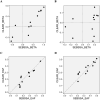A genome-wide association study for rheumatoid arthritis replicates previous HLA and non-HLA associations in a cohort from South Africa
- PMID: 35925860
- PMCID: PMC9759327
- DOI: 10.1093/hmg/ddac178
A genome-wide association study for rheumatoid arthritis replicates previous HLA and non-HLA associations in a cohort from South Africa
Abstract
The complex pathogenesis of rheumatoid arthritis (RA) is not fully understood, with few studies exploring the genomic contribution to RA in patients from Africa. We report a genome-wide association study (GWAS) of South-Eastern Bantu-Speaking South Africans (SEBSSAs) with seropositive RA (n = 531) and population controls (n = 2653). Association testing was performed using PLINK (logistic regression assuming an additive model) with sex, age, smoking and the first three principal components as covariates. The strong association with the Human Leukocyte Antigen (HLA) region, indexed by rs602457 (near HLA-DRB1), was replicated. An additional independent signal in the HLA region represented by the lead SNP rs2523593 (near the HLA-B gene; Conditional P-value = 6.4 × 10-10) was detected. Although none of the non-HLA signals reached genome-wide significance (P < 5 × 10-8), 17 genomic regions showed suggestive association (P < 5 × 10-6). The GWAS replicated two known non-HLA associations with MMEL1 (rs2843401) and ANKRD55 (rs7731626) at a threshold of P < 5 × 10-3 providing, for the first time, evidence for replication of non-HLA signals for RA in sub-Saharan African populations. Meta-analysis with summary statistics from an African-American cohort (CLEAR study) replicated three additional non-HLA signals (rs11571302, rs2558210 and rs2422345 around KRT18P39-NPM1P33, CTLA4-ICOS and AL645568.1, respectively). Analysis based on genomic regions (200 kb windows) further replicated previously reported non-HLA signals around PADI4, CD28 and LIMK1. Although allele frequencies were overall strongly correlated between the SEBSSA and the CLEAR cohort, we observed some differences in effect size estimates for associated loci. The study highlights the need for conducting larger association studies across diverse African populations to inform precision medicine-based approaches for RA in Africa.
© The Author(s) 2022. Published by Oxford University Press. All rights reserved. For Permissions, please email: journals.permissions@oup.com.
Figures


Similar articles
-
A Multinational Arab Genome-Wide Association Study Identifies New Genetic Associations for Rheumatoid Arthritis.Arthritis Rheumatol. 2017 May;69(5):976-985. doi: 10.1002/art.40051. Epub 2017 Mar 31. Arthritis Rheumatol. 2017. PMID: 28118524
-
Immunochip identifies novel, and replicates known, genetic risk loci for rheumatoid arthritis in black South Africans.Mol Med. 2014 Aug 14;20(1):341-9. doi: 10.2119/molmed.2014.00097. Mol Med. 2014. PMID: 25014791 Free PMC article.
-
Caucasian and Asian specific rheumatoid arthritis risk loci reveal limited replication and apparent allelic heterogeneity in north Indians.PLoS One. 2012;7(2):e31584. doi: 10.1371/journal.pone.0031584. Epub 2012 Feb 15. PLoS One. 2012. PMID: 22355377 Free PMC article.
-
Genetics of rheumatoid arthritis - a comprehensive review.Clin Rev Allergy Immunol. 2013 Oct;45(2):170-9. doi: 10.1007/s12016-012-8346-7. Clin Rev Allergy Immunol. 2013. PMID: 23288628 Free PMC article. Review.
-
Genetic implications in the pathogenesis of rheumatoid arthritis; an updated review.Gene. 2019 Jun 20;702:8-16. doi: 10.1016/j.gene.2019.03.033. Epub 2019 Mar 20. Gene. 2019. PMID: 30904715 Review.
Cited by
-
Global clinical trials on stem cell therapy for autoimmune diseases: trends and future directions.Front Immunol. 2025 Jul 24;16:1616231. doi: 10.3389/fimmu.2025.1616231. eCollection 2025. Front Immunol. 2025. PMID: 40777013 Free PMC article.
-
The benefits and pitfalls of machine learning for biomarker discovery.Cell Tissue Res. 2023 Oct;394(1):17-31. doi: 10.1007/s00441-023-03816-z. Epub 2023 Jul 27. Cell Tissue Res. 2023. PMID: 37498390 Free PMC article. Review.
-
Genome-wide association study of population-standardised cognitive performance phenotypes in a rural South African community.Commun Biol. 2023 Mar 27;6(1):328. doi: 10.1038/s42003-023-04636-1. Commun Biol. 2023. PMID: 36973338 Free PMC article.
-
Genome-wide association study identifying novel risk variants associated with glycaemic traits in the continental African AWI-Gen cohort.Diabetologia. 2025 Jun;68(6):1184-1196. doi: 10.1007/s00125-025-06395-6. Epub 2025 Mar 1. Diabetologia. 2025. PMID: 40025146 Free PMC article.
-
The genetic puzzle of rheumatoid arthritis: Causes, progression, and treatment.Biochem Biophys Rep. 2025 Jul 21;43:102148. doi: 10.1016/j.bbrep.2025.102148. eCollection 2025 Sep. Biochem Biophys Rep. 2025. PMID: 40734997 Free PMC article. Review.
References
-
- Mody, G.M., Shaw, J. and Ramchurren, A. (1988) Rheumatoid arthritis impact survey. S. Afr. Med. J., 74, 409–410. - PubMed
-
- Kalla, A.A. and Tikly, M. (2003) Rheumatoid arthritis in the developing world. Best Pract. Res. Clin. Rheumatol., 17, 863–875. - PubMed
-
- Firestein, G.S. (2003) Evolving concepts of rheumatoid arthritis. Nature, 423, 356–361. - PubMed
-
- Klareskog, L., Stolt, P., Lundberg, K., Källberg, H., Bengtsson, C., Grunewald, J., Rönnelid, J., Harris, H.E., Ulfgren, A.-K., Rantapää-Dahlqvist, S. et al. (2006) A new model for an etiology of rheumatoid arthritis: smoking may trigger HLA-DR (shared epitope)-restricted immune reactions to autoantigens modified by citrullination. Arthritis Rheum., 54, 38–46. - PubMed
Publication types
MeSH terms
Substances
Grants and funding
LinkOut - more resources
Full Text Sources
Medical
Research Materials

